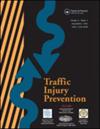南澳大利亚州致命和伤害事故中的系统故障和极端行为。
IF 1.9
3区 工程技术
Q3 PUBLIC, ENVIRONMENTAL & OCCUPATIONAL HEALTH
引用次数: 0
摘要
目标:在道路系统中,有些遵守规定的道路使用者可能会犯错,导致撞车事故,这表明 "系统故障"。还有一些道路使用者故意冒险,做出危险或 "极端 "行为,导致撞车事故。本研究旨在评估系统故障和极端行为的相对影响,以指导未来战略和干预措施的制定,从而创建安全系统并预防道路创伤:本研究采用了与 Wundersitz 等人相同的方法,以提供关于系统故障和极端行为在近期车祸中的相对作用的最新信息。研究使用了两个样本:157 起致命碰撞事故来自法医调查档案,235 起受伤碰撞事故来自汽车安全研究中心进行的深入碰撞调查:与之前的研究结果一致,研究结果表明,南澳大利亚州的大多数致命车祸(70%)和受伤车祸(93%)都可归因于道路交通系统的故障。在近一半的致命交通事故和 72% 的受伤交通事故中,道路使用者完全遵守了相关规定(即没有违法行为)。通过比较不同时期的相对比例发现,极端行为在致命碰撞事故中所占的比例有所下降,这可能至少部分归因于南澳大利亚州与酒精有关的碰撞事故有所减少:总体而言,研究结果表明,继续关注道路运输系统的系统性改进,如提供安全的道路基础设施(如侧护栏和中央护栏)和加速采用安全车辆技术(如车道保持技术、自主紧急制动),可望有效降低大部分致命和重伤交通事故的发生率和严重程度。对于更极端的行为,可能需要通过更多地使用车辆技术和更全面的社会健康举措,对道路使用者的行为进行更大程度的控制。本文章由计算机程序翻译,如有差异,请以英文原文为准。
System failures and extreme behavior in fatal and injury crashes in South Australia
Objectives
Within the road system, there are compliant road users who may make an error that leads to a crash, indicating a “system failure.” There are also road users who deliberately take risks and engage in dangerous or “extreme” behavior that leads to a crash. This study aims to assess the relative contribution of system failures and extreme behavior to guide the development of future strategies and interventions needed to create a safe system and prevent road trauma.
Methods
This study used the same methodology as Wundersitz et al. to provide an update on the relative contribution of system failures and extreme behaviors in more recent crashes. Two samples were used for the study: 157 fatal crashes from Coroner’s investigation files and 235 injury crashes from in-depth crash investigations conducted by the Center for Automotive Safety Research.
Results
Consistent with previous findings, the results indicated that the majority of fatal (70%) and injury crashes (93%) in South Australia were attributable to failures within the road transport system. In almost half of the fatal crashes and 72% of injury crashes, road users were fully compliant (i.e., no illegal behaviors). A comparison of the relative contributions over time revealed that the proportion of extreme behaviors in fatal crashes has decreased, which may be, at least partly, attributable to a reduction in alcohol-related crashes within South Australia.
Conclusions
Overall, the findings suggest that strategies continuing to focus on system wide improvements to the road transport system such as providing safe road infrastructure (e.g., side and center barriers) and the accelerated uptake of safe vehicle technologies (e.g., lane keeping technology, autonomous emergency braking) can be expected to be effective in reducing the incidence and severity of a large proportion of fatal and serious injury crashes. For more extreme behaviors, greater control of road user behavior may be required through the increased use of vehicle technologies and more holistic social health initiatives.
求助全文
通过发布文献求助,成功后即可免费获取论文全文。
去求助
来源期刊

Traffic Injury Prevention
PUBLIC, ENVIRONMENTAL & OCCUPATIONAL HEALTH-
CiteScore
3.60
自引率
10.00%
发文量
137
审稿时长
3 months
期刊介绍:
The purpose of Traffic Injury Prevention is to bridge the disciplines of medicine, engineering, public health and traffic safety in order to foster the science of traffic injury prevention. The archival journal focuses on research, interventions and evaluations within the areas of traffic safety, crash causation, injury prevention and treatment.
General topics within the journal''s scope are driver behavior, road infrastructure, emerging crash avoidance technologies, crash and injury epidemiology, alcohol and drugs, impact injury biomechanics, vehicle crashworthiness, occupant restraints, pedestrian safety, evaluation of interventions, economic consequences and emergency and clinical care with specific application to traffic injury prevention. The journal includes full length papers, review articles, case studies, brief technical notes and commentaries.
 求助内容:
求助内容: 应助结果提醒方式:
应助结果提醒方式:


